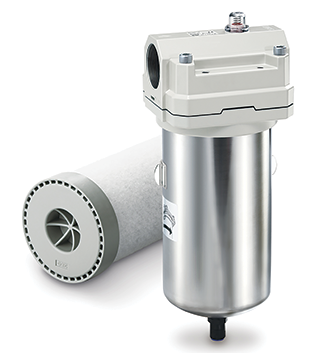

A leading cause of costly downtime and emergency maintenance is water vapour and the resulting condensed water that is trapped in factory compressed air.
Water in facility airlines can cause corrosion, rust and pipe scale, which can break loose to block or adhere to air passageways, and lead to increased pressure drop and loss in machine performance. Machine components will suffer premature wear and parts deterioration from water:
• Pneumatic cylinders will have their pre-lubricants washed away, corrode and respond slower.
• Solenoid valves’ rubber seals will stiffen and become more susceptible to rupturing and leaking.
• Instrumentation can malfunction even with the presence of only a small amount of moisture.
• Air powered tools will likely stick and perform less efficiently.
End products are also at risk of suffering quality deterioration because of water:
• Spray painting will be adversely affected by change in colour, adherence and finish quality.
• Industrial ink-jet printers will be adversely affected by change in adherence and finish quality.
• Blow moulding plastic bottles’ viscosity and material consistency could be adversely affected.
• Glueing/taping adhesiveness of cardboard boxes could be adversely affected.
• Pharmaceutical mixing and integrity could be adversely affected.
• Food processing may be contaminated because of micro-organism growth.

How does water vapour enter factory compressed air?
All atmospheric air contains contaminants and water vapour that is concentrated during the compression process. The heat generated during compression increases the capacity of the compressed air to hold moisture, thus avoiding condensation inside the compressor. Lubricants used to improve the efficiency and life of the compressor also become part of the contaminant load, as do wear particles.
A compressor with a 75 kW capacity, operating at 30°C ambient temperature, a relative humidity of 80%, compressing air to 7 bar, can produce approximately 113 litres of condensate during an eight-hour shift.
Removing liquefied water from factory compressed air
Aftercoolers
The compressed air exiting the compressor can reach temperatures as high as 150°C, which is unusable for industrial applications. This hot, saturated air will release 70-80% of its excess water vapour if simply cooled to near room temperatures. To achieve this type of cooling and bulk moisture removal, air- or water-cooled aftercoolers are often employed. Condensed liquid is removed from the aftercooler via automatic condensate drains.
The air exiting the aftercooler will still be saturated but at a much more manageable temperature. Because the air is at a dew point of 37°C or more, it is still vulnerable to further condensation into liquid water should it be exposed to temperatures lower than this dew point. The piping in most industrial facilities would allow for further temperature fluctuation, thereby allowing more condensation to take place as the air moves through the plant.

Drip legs
The next line of defence for removing the water is a drip leg. This is a vertical pipe plumbed at the air drop line (below the horizontal header pipe) to allow water to be drained away using the principle of rapid air expansion to condense water vapour into liquid water. The condensate is then removed by a drain at the bottom of the drip leg, which can be automatically or manually drained to avoid overflow of contaminants.
Water separators
Water separators use mechanical separation techniques to remove condensed water in bulk from factory air, either by directing inlet air into a spiral and using centrifugal force to separate the water out from the compressed air, or by passing the inlet air through a special resin filter element with large meshes to trap water particles that will drop down to a collection bowl allowing the compressed air to pass through.
SMC’s AMG Series water separator can remove water droplets (up to a 99% removal rate) using a special resin filter. It is easy to install and requires no electrical power.
| Tel: | +27 11 100 5866 |
| Email: | [email protected] |
| www: | www.smcza.co.za |
| Articles: | More information and articles about SMC Corporation South Africa |

© Technews Publishing (Pty) Ltd | All Rights Reserved